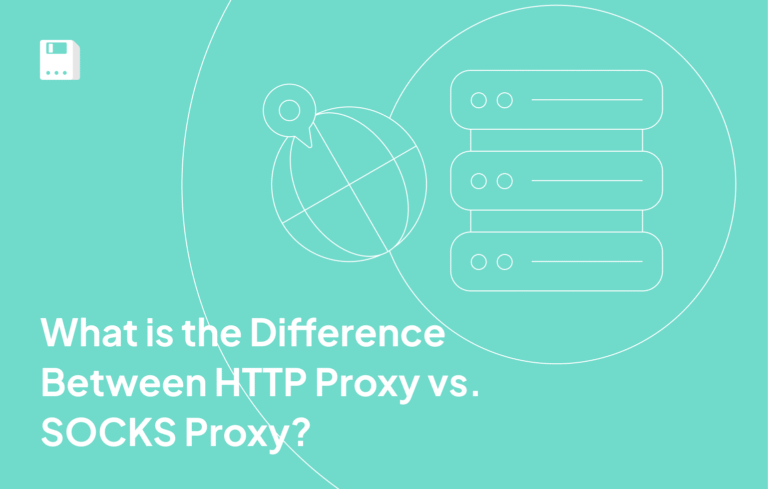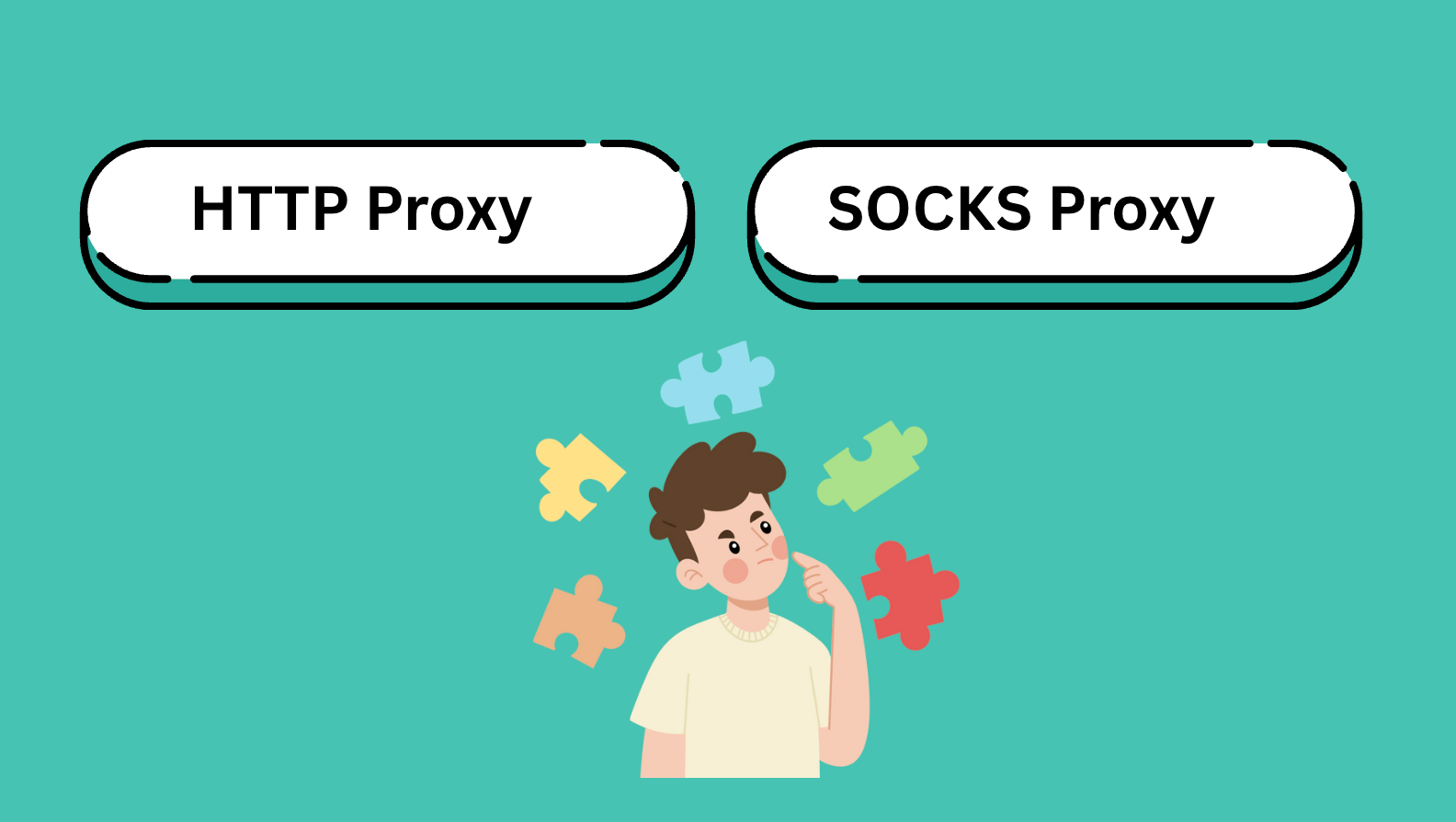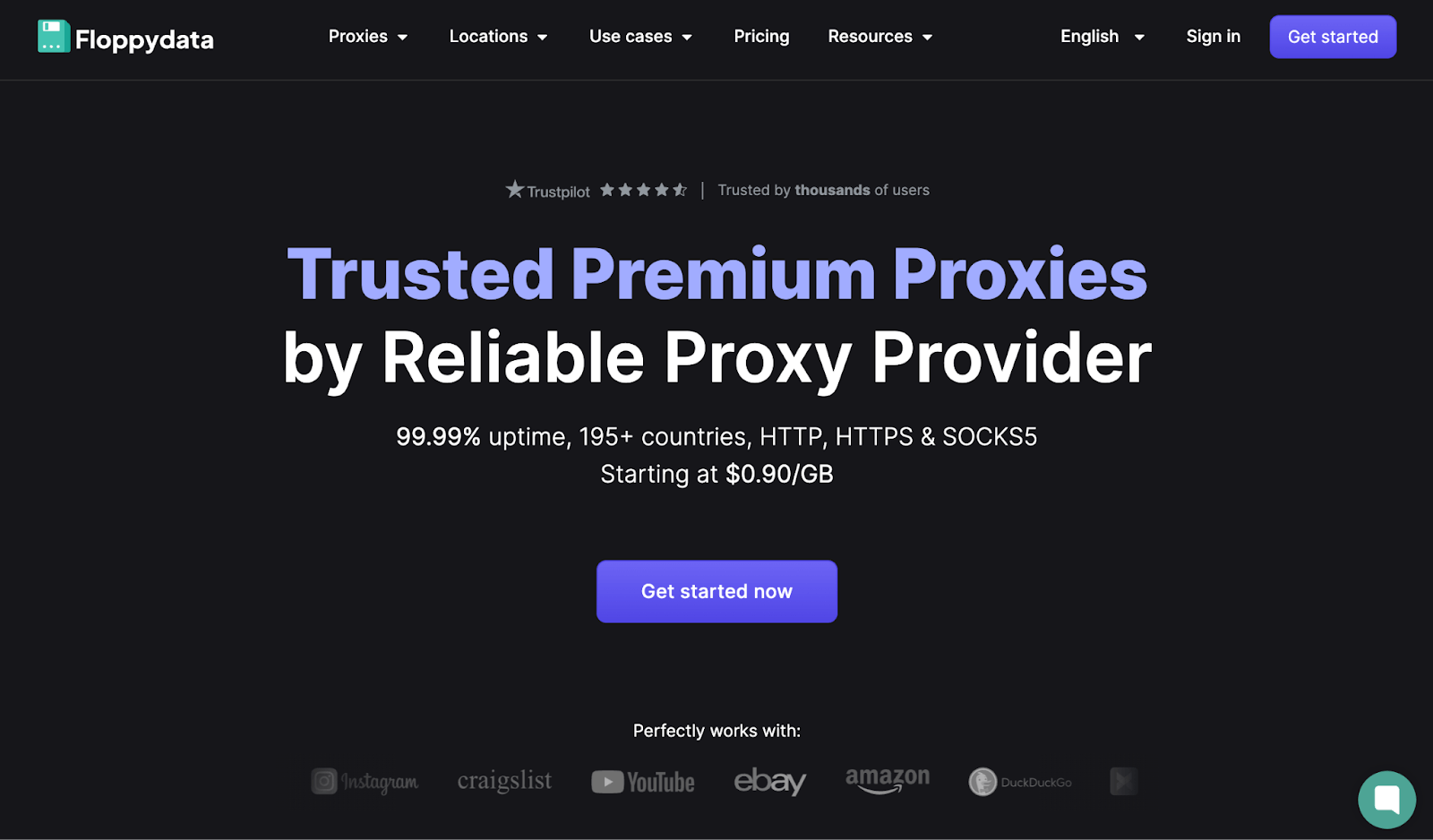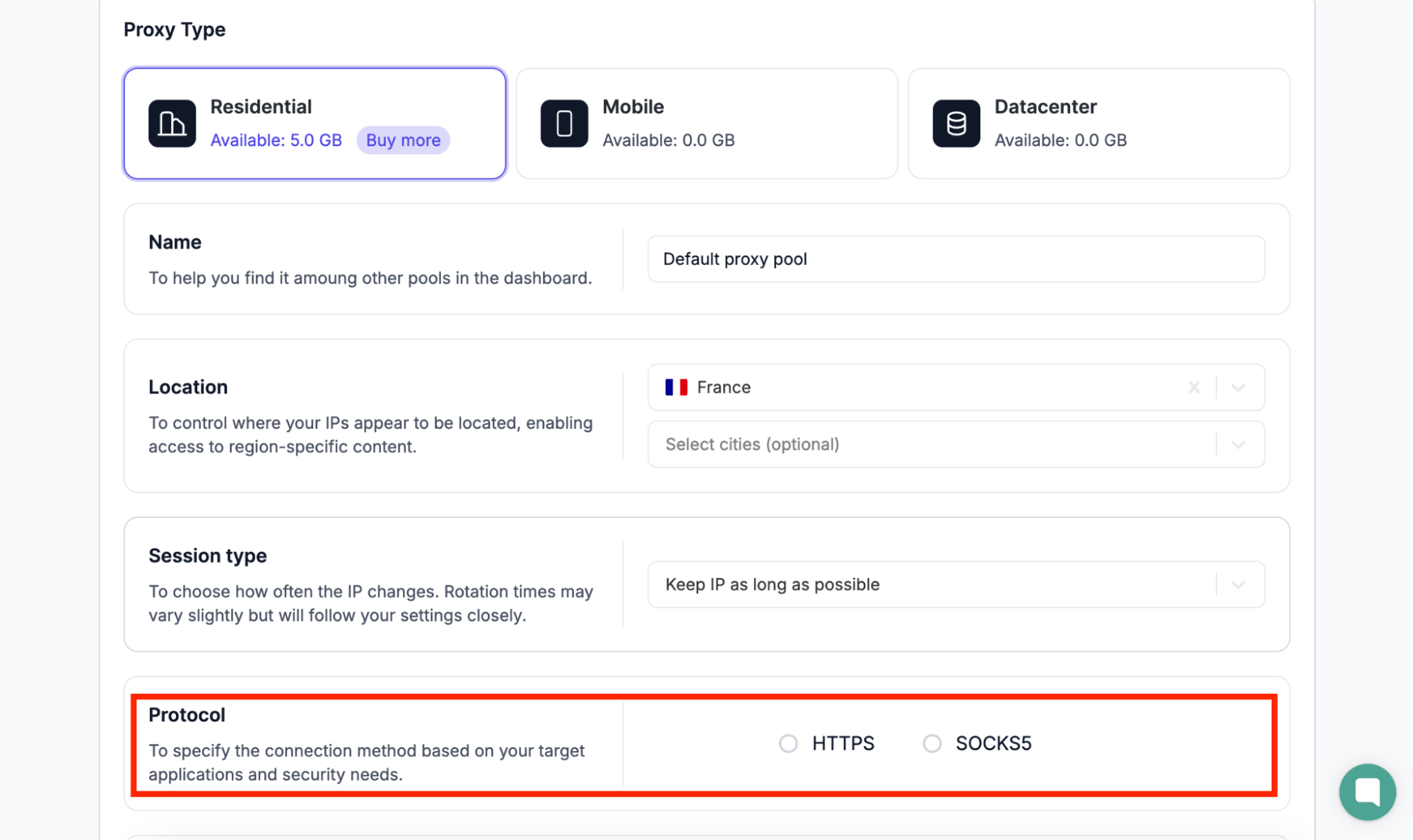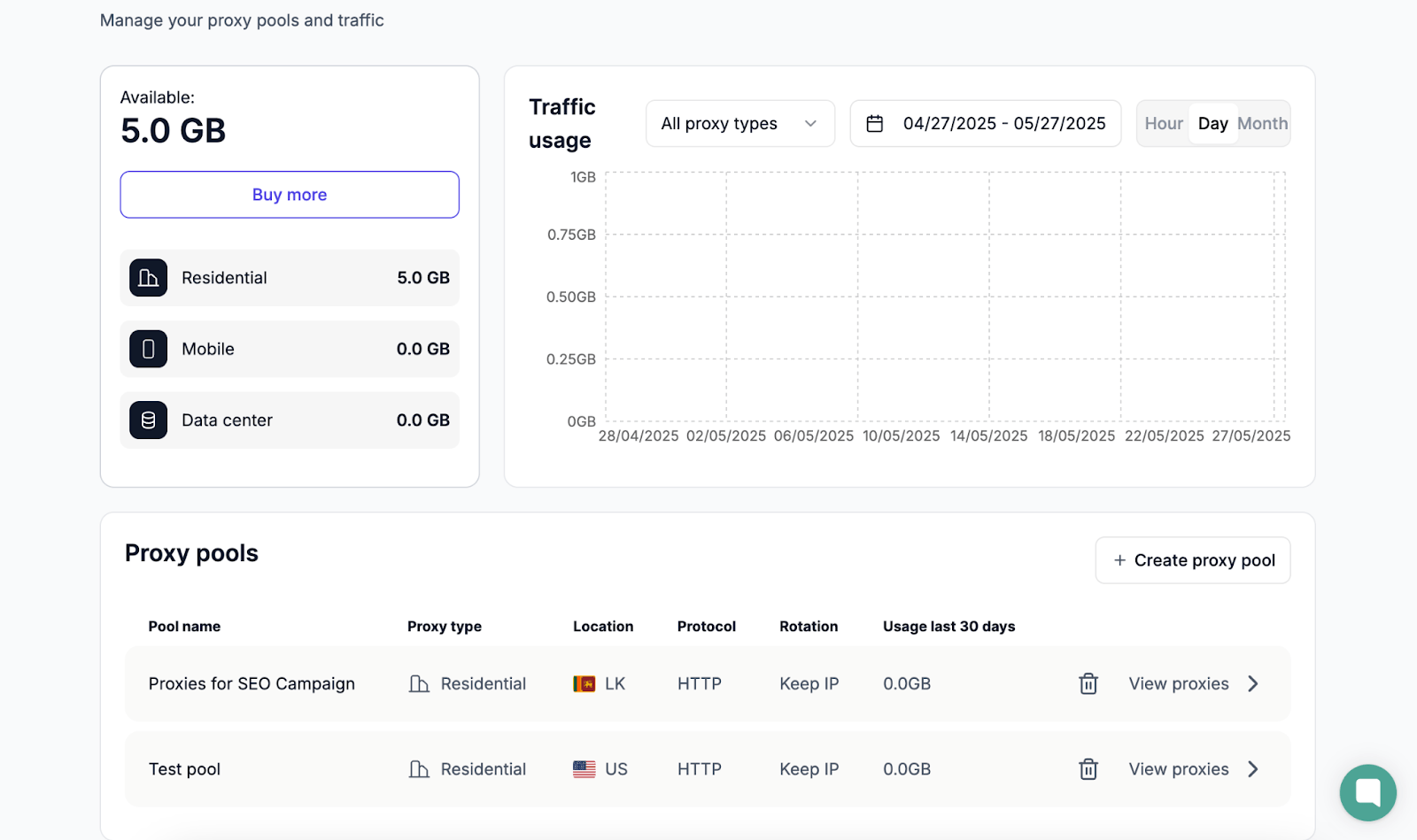Why do I need a proxy almost every day? Because not all the websites and software applications I use work where I live.
Some websites I rely on for research are blocked in my region. In those cases, HTTP proxies help me out. What about apps like Telegram or uTorrent? Or trying to join a game server that’s restricted by location? That’s when I switch to SOCKS proxies to get around the blocks.
The more I used them, the more I realized that not all proxies are the same. Understanding the difference between a SOCKS proxy vs HTTP proxy helped me avoid picking the wrong ones. I will use this article to share my experience on what each type does best, how they compare, and when to use which.
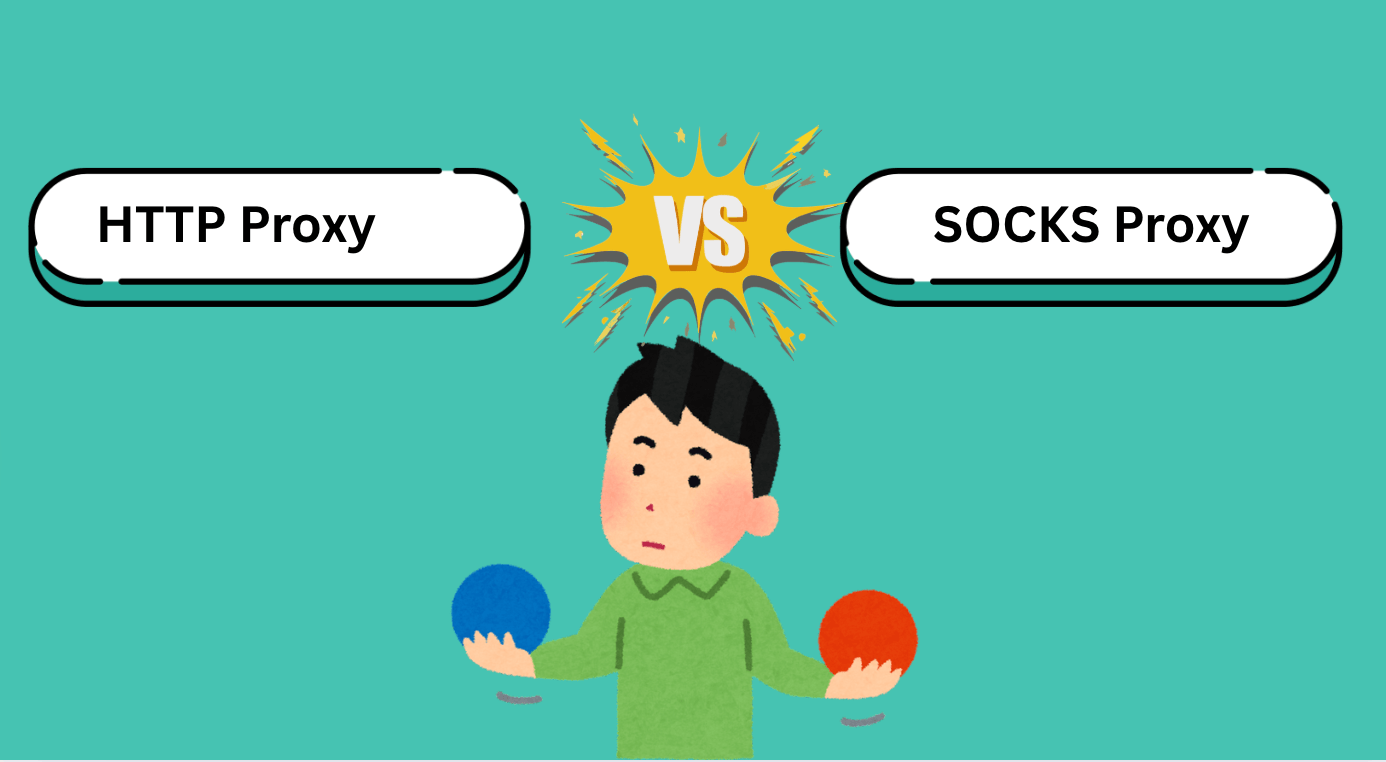
What is an HTTP proxy?
You’ve probably seen the term “HTTP proxy” while setting up a browser, scraper, or automation tool, but what’s the actual HTTP proxy meaning?
It simply refers to a proxy server that handles web traffic, specifically HTTP and HTTPS.
Let’s say I’ve already set up an HTTP proxy in my browser settings. Now, I type the URL for a top-rated YouTube video into my browser and hit Enter. Instead of the request going straight to YouTube, it first passes through the HTTP proxy. The proxy then contacts YouTube, fetches the video data, and sends it back to my browser.
It’s a classic client-server model. Your browser (the client) makes a request. The web server responds. And the proxy sits quietly in the middle to translate all communication in HTTP format. That means requests and responses are structured as web messages with headers, status codes, and content designed specifically for the web.
What is a SOCKS proxy?
A SOCKS proxy is designed to handle all kinds of internet traffic, not limited to websites.
It works with any protocol: FTP, SMTP, P2P, gaming apps, etc..
A SOCKS proxy doesn’t interpret the data like an HTTP proxy would. It simply opens a connection and blindly passes traffic between you and the destination.
That makes it faster and more flexible for anything that isn’t browser-based.
Say there’s a newly released movie that’s only available through torrent and I want to download it. I configure my torrent client to use a SOCKS proxy, then start the download.
Now, instead of connecting directly to random peers, the traffic routes through the SOCKS proxy. It forwards the data without interference, keeps my IP hidden, and avoids any throttling or restrictions from my ISP.
If you’re trying to understand what SOCKS proxy is good for, it all comes down to flexibility.
Moreover, below are a few more things SOCKS proxies are especially useful for
- Hides your real IP across all types of apps and protocols
- Bypasses restrictions in games, messaging tools, or blocked services
- Supports authentication (like username and password)
- Handles both TCP and UDP traffic
HTTP proxy vs SOCKS proxy? Here’s how I choose the right one
When it comes to HTTP proxy vs SOCKS, I’ve used both HTTP and SOCKS proxies across different workflows, and one thing I’ve learned is that there’s no universal “best.” It all depends on what you’re trying to do.
Here’s how I decide which one to use, based on the actual tasks I’ve run.
Collecting web data
When I need clean, structured web data like scraping product listings or parsing search results, I always go with HTTP proxies.
Why? Because they understand web traffic.
That means they can cache pages, reduce bandwidth, and even help modify headers to avoid getting blocked.
SOCKS doesn’t help here. It can’t read web traffic. It only passes it along. But with HTTP, I can control headers, rotate IPs, and optimize each request for accuracy.
Streaming or torrenting
For tasks that aren’t browser-based, like testing media delivery or handling large video files, I switch to SOCKS proxies.
And because it supports UDP, it’s faster and more reliable for high-volume, real-time traffic. In these cases, the SOCKS5 vs HTTP proxy difference becomes clear, and HTTP isn’t built for this kind of job.
Getting around firewalls
When I’m dealing with a client stuck behind a strict firewall or filtering rules, SOCKS5 is my go-to.
It’s flexible with ports and protocols, so I can tunnel out of locked-down environments that block HTTP connections. Especially useful for tools that aren’t built to work with proxies natively.
HTTP proxies can work too, but only if the destination is web-based, which isn’t always the case.
Scraping public websites at scale
If I’m scraping at volume, especially public web pages that use rate limiting, HTTP proxies give me the control I need.
I can rotate headers, throttle requests, and even cache static pages to reduce load. They help reduce detection, manage session behavior, and support high success rates.
SOCKS can do the volume too, but lacks the web-specific tools for evading detection.
Using apps with no proxy settings
Sometimes I work with apps, legacy desktop tools, game clients, or messaging software that don’t provide the capability for you to set a proxy.
In such cases, I will go with SOCKS proxies as they work at the socket level, so you can route any application’s traffic through them with a bit of local configuration.
Key differences: HTTP vs SOCKS proxies
I can tell you that HTTP and SOCKS proxies are not interchangeable. Each one has strengths. Each one has weaknesses.
So instead of asking “Which one’s better?” I ask, “What do I need it to do?”
Now, I’ll break it down across the categories that matter most.
1. Protocol support
HTTP proxies speak the same language as your browser, so they’re perfect for anything web-based.
SOCKS proxies are protocol-agnostic. They handle HTTP, FTP, SMTP, P2P, and gaming.
If you need flexibility across different protocols, SOCKS takes the lead.
2. Data handling
HTTP proxies can actually interpret web traffic. That means they can filter, cache, and even modify the data being passed between you and the website.
SOCKS proxies don’t touch the data. They only tunnel it. No inspection, no filtering.
When it comes to content-aware tasks, HTTP comes out on top. Its ability to read and manipulate data gives it the upper hand.
3. Speed and performance
SOCKS proxies are lean. They don’t inspect or process your traffic, which makes them fast for downloading, streaming, or transferring large files.
HTTP proxies can slow things down a bit because they do more like analyzing and caching. But for web browsing, they’re still efficient.
Therefore, SOCKS has better performance with high-bandwidth or raw data transfers, whereas HTTP is more effective for smart, web-focused tasks.
4. Security
HTTP proxies can inspect traffic, block malicious content, and filter access to certain websites. Some setups even add SSL for safer browsing.
SOCKS5 proxies support authentication and can tunnel encrypted traffic, which is useful when paired with tools like SSH.
When it comes to security, HTTP is better for content-based filtering and malware protection, while SOCKS5 is the stronger choice for secure tunneling and broader protocol support.
5. Anonymity and IP masking
Both proxy types hide your real IP, but in different ways.
SOCKS5 proxies tend to be harder to detect and more anonymous in mixed traffic environments.
HTTP proxies can still mask your IP, but are more easily identified by web servers.
For tasks that require strong anonymity across various types of traffic, SOCKS5 stands out as the better option.
6. Firewall and network access
SOCKS proxies are better at punching through firewalls and restricted networks. Because they work on any port and don’t rely on HTTP, they’re harder to block.
HTTP proxies can still be blocked by firewalls that restrict web protocols or known proxy IPs.
When it comes to bypassing restrictions or firewalls, SOCKS provides greater versatility and is often the more effective choice.
7. Geo-targeting accuracy
For location-sensitive scraping or ad testing, I always stick with HTTP proxies, mainly residential ones. They’re optimized for web geolocation and deliver region-specific results more reliably.
SOCKS proxies still work for geo-masking, but they can be overkill if your goal is purely web-based.
Therefore, for browser-based geo-targeting, HTTP proxies are typically more accurate and better optimized for the task.
8. Use in proxy chaining and tunnels
When I’m building layered privacy setups or working with Tor-style proxy chains, I go with SOCKS. It’s often used in advanced setups that include SSH tunnels or multi-hop routes.
HTTP proxies aren’t designed for this kind of tunneling and usually break under chained setups.
For advanced routing and proxy chaining setups, SOCKS provides the flexibility needed to handle complex configurations.
SOCKS vs SOCKS4 vs SOCKS5
At first, I thought SOCKS proxies were all the same. If it said SOCKS, I assumed it just worked. But the difference between SOCKS4 and SOCKS5 turned out to be bigger than I expected.
So here’s how I usually explain it when someone asks me what a SOCKS proxy really is.
SOCKS comes in two main types as SOCKS4 and SOCKS5.
SOCKS4 was one of the earliest versions. It still works, but it’s extremely limited.
- Only supports TCP traffic (no UDP)
- No support for authentication
- Doesn’t allow remote DNS and DNS lookups to happen locally
- Can’t handle IPv6 or newer protocols
It can forward basic data, but if you’re doing anything more advanced or want more privacy, SOCKS4 won’t work for you.
SOCKS5 is the modern standard, and usually what people mean when they say SOCKS. It improves on SOCKS4 in almost every way.
- Authentication support (username + password)
- Handles both TCP and UDP traffic
- Supports remote DNS resolution (helps anonymize DNS queries)
- Compatible with IPv6
- Works well with SSH tunneling for secure encryption
- Fully anonymous and more secure overall
If you’re deciding between SOCKS5 vs SOCKS4, SOCKS5 is the go-to option. It’s really good at streaming, torrenting, app traffic, or anything where speed, security, and protocol flexibility matter.
Which proxy protects you better, HTTP or SOCKS
Which is safer between HTTP and SOCKS?
The answer depends on how you’re using them. Ultimately, it’s not about which proxy is “more secure” in general. It’s about using the right one for the right job.
HTTP proxies have the advantage of inspecting traffic. That means they can filter out malware, block dangerous sites, and even scan requests for malicious patterns. If you’re doing tasks like scraping, browsing, or managing content, this extra visibility can act like a built-in security layer.
But that same visibility means HTTP proxies can see your traffic. If the proxy itself isn’t secure or the traffic isn’t encrypted (like over HTTPS), your data could be exposed. In sensitive environments, that’s a risk.
SOCKS5 proxies, on the other hand, might sound less secure, but they actually work in your favor if you’re pairing SOCKS with encrypted apps or VPNs. SOCKS5 also supports authentication, remote DNS, and handles more traffic types.
So what do I recommend?
- For content-level filtering and controlled web access → go with HTTP
- For secure tunneling, anonymity, and app-based traffic → SOCKS5 is the safer bet
How do I set up HTTP or SOCKS proxies?
I used to think setting up proxies would be complicated, but FloppyData made it surprisingly fast and easy.
Their dashboard is simple, even if you’re new to proxies. You can create and manage proxy pools, pick your protocol (HTTP or SOCKS5), and get your credentials all in one place.
Access floppydata.com and sign up or log in.
From the dashboard, you can see the available bandwidth, traffic usage, and proxy types (Residential, Mobile, Datacenter).
Click “Create proxy pool” to create a new pool.
Choose your settings:
- Proxy type – Residential, Mobile, or Datacenter
- Location – Select a country or narrow it down to specific cities
- Session type – Choose how long to keep the same IP (e.g., “Keep IP as long as possible”)
- Protocol – Select either HTTP or SOCKS5 based on the intended use
- Proxies quantity – Choose how many proxies to generate. 10 is a good starting point for most tasks.
Go to “Proxy pools” and click “View proxies” to access your proxy list.
View your proxy credentials, including host, port, username, and password for each proxy.
Copy individual entries or download the full list as a .txt file. This is ideal for importing into scrapers, browsers, or automation tools.
Why I recommend FloppyData over others for HTTP and SOCKS5 proxies
There’s a reason I’ve stuck with FloppyData after trying half a dozen other proxy providers. It just worked for me, no matter the use case, whether I needed HTTP for scraping or SOCKS5 for app traffic. And honestly, that’s too much to ask from most proxy providers.
A lot of services claim 99% uptime, but FloppyData is the only one where I’ve actually experienced it consistently. And most importantly, their IPs are legitimately clean. With other providers, I’ve often run into proxies that were already flagged.
Another big win for me was their large coverage. In my work, I often need proxies from various countries, even obscure regions that most proxy services fail to support. But FloppyData had all of them covered, so I never had to look elsewhere.
And whenever I needed support, FloppyData’s 24/7 team didn’t disappoint me.
So my recommendation is: whether you need HTTP vs SOCKS5, FloppyData covers both really well, and you won’t have trouble using either.
The pricing is also beginner-friendly. Plans start as low as $0.90/GB, which works whether you’re testing a few scripts or running full-scale operations.
Getting started takes just a few minutes. Sign up, choose your proxy type, and you’re ready to go.
FAQ
What’s the key difference between HTTP and SOCKS proxies?
An HTTP proxy understands and interprets web traffic (HTTP/S), enabling features like caching and filtering. In contrast, a SOCKS proxy operates at a lower level and simply forwards all types of traffic - such as FTP, email, torrents, or gaming - without interpreting it, offering greater flexibility and speed.
When should I choose HTTP vs. SOCKS proxy?
Choose an HTTP proxy when you're focusing on web-based tasks like browsing or scraping - since it can enhance performance with caching and filtering. Opt for a SOCKS proxy when you need a protocol-agnostic solution for varied internet traffic or applications beyond just web browsing.
Share this article:
Table of Contents
Proxies at $1
Get unlimited possibilities

